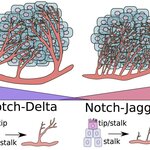Cancer Research

Researchers have built a simulation to show how cancerous tumors manipulate blood-vessel growth for their own benefit.
Like all cells, those in tumors need access to the body's fine network of blood vessels to bring them oxygen and carry away waste. Tumors have learned to game the process called angiogenesis in which new vessels sprout from existing ones, like branches from a tree.
But some details have been hidden until now.
New research at Rice University shows how tumors create chaos in the development of neighboring blood vessels, causing them to grow too quickly and not form properly.…

A mutation found in most melanomas rewires cancer cells' metabolism, making them dependent on a ketogenesis enzyme, researchers at Winship Cancer Institute of Emory University have discovered. The finding points to possible strategies for countering resistance to existing drugs that target the B-raf V600E mutation, or potential alternatives to those drugs. It may also explain why the V600E mutation in particular is so common in melanomas.
The growth-promoting V600E mutation in the gene B-raf is present in most melanomas, and also in some cases of colon and thyroid cancer. Drugs such as…
Cancer cells play it dirty to get what they want. They are survival artists with a strong criminal streak. They surround themselves with a protective shield of extra-cellular material and then secure supply lines by attracting new blood vessels.
To achieve both of these aims, they set immune cells a honey trap by releasing attractants in the form of messenger molecules which lure immune cells to growing tumours. At the cancer site, the abducted immune cells release growth hormones to guide new blood vessels to the tumour and help build a protective shield.
Since immune cells are hard to come…

Scientists at St. Jude Children's Research Hospital have discovered how an immune system protein, called AIM2 (Absent in Melanoma 2), plays a role in determining the aggressiveness of colon cancer. They found that AIM2 deficiency causes uncontrolled proliferation of intestinal cells. Surprisingly, they also discovered that AIM2 influences the microbiota -- the population of gut bacteria -- apparently fostering the proliferation of 'good' bacteria that can protect against colon cancer.
The team, led by Thirumala-Devi Kanneganti, Ph.D., a member of the St. Jude Department of Immunology, said…

A new study is helping to shed light on latent tuberculosis and the bacteria's ability to hide in stem cells.
Some bone marrow stem cells reside in low oxygen (hypoxia) zones. These specialized zones are secured as immune cells and toxic chemicals cannot reach this zone. Hypoxia- activated cell signaling pathways may also protect the stem cells from dying or ageing.
A new study led by Forsyth Scientist Dr. Bikul Das has found that Mycobacterium tuberculosis (Mtb) hijack this protective hypoxic zone to hide intracellular to a special stem cell type.
Mtb, the causative organism of…

Researchers at the Université libre de Bruxelles, ULB uncover a new mechanism that regulates tumour initiation and invasion in skin basal cell carcinoma.
Basal cell carcinoma (BCC) is the most common cancer found in human with several million of new patients affected every year around the world. The mechanisms that control BCC initiation and invasion are poorly known.
In a new study, researchers led by Pr. Cédric Blanpain, MD/PhD, professor and WELBIO investigator at the IRIBHM, Université libre de Bruxelles, Belgium, report that Sox9, directly controls skin cancer formation by regulating the…

New research published in Liver Transplantation, a journal of the American Association for the Study of Liver Diseases and the International Liver Transplantation Society, reports that younger patients, those who are married, and those with Child-Pugh C disease—the most severe measure of liver disease—are more likely immigrants, divorced patients and those at the lowest income levels were less likely to have a potential live donor volunteer for liver donation.
With a limited supply of deceased donor organs, livers from living donors provide a much needed, life-saving option for those…

Melanoma patients with high levels of a protein that controls the expression of pro-growth genes are less likely to survive, according to a study led by researchers at Icahn School of Medicine at Mount Sinai and published online in the journal Molecular Cell.
The research team found that the protein, called H2A.Z.2, promotes the abnormal growth seen in melanoma cells as they develop into difficult-to-treat tumors. H2A.Z.2 is part of the chromosome structure that packages genes, and has the ability to switch them on off. Having high levels of this protein aberrantly activates growth-promoting…

Some brain tumors are notoriously difficult to treat. Whether surgically removed, zapped by radiation or infiltrated by chemotherapy drugs, they find a way to return.
The ability of many brain tumors to regenerate can be traced to cancer stem cells that evade treatment and spur the growth of new tumor cells.
But some brain tumor stem cells may have an Achilles' heel, scientists have found. The cancer stem cells' remarkable abilities have to be maintained, and researchers at Washington University School of Medicine in St. Louis have identified a key player in that maintenance process. When the…

This month marks the 10-year anniversary of the first successful total marrow irradiation (TMI) using the TomoTherapy System, first performed at City of Hope in Duarte, California. Since then, numerous centers around the world have adopted the approach, once considered to be impossible because of limitations inherent to conventional radiation therapy systems.
TMI is an advanced form of total body irradiation, which has traditionally been an important part of bone marrow transplants (BMT). People with certain types of cancers or other diseases including leukemias, lymphomas and multiple…